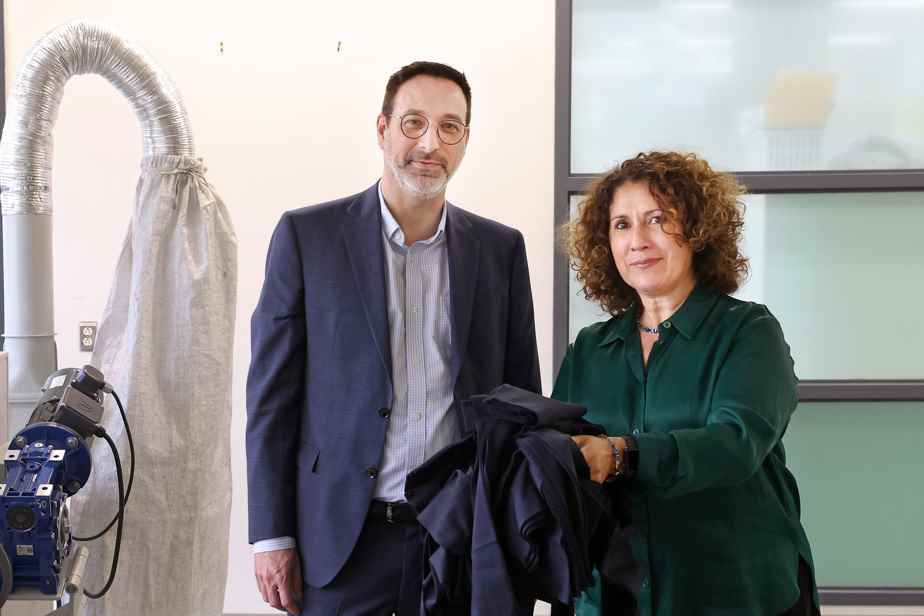In 10 years, the proportion of clothing, bedding and other textiles found in landfills and incineration sites in the province has doubled, according to data from Recyc-Québec. In order to “be part of the solution”, the Renaissance organization launched a pilot project a year ago to find ways to recycle or reuse these unloved textiles. As Quebec Waste Reduction Week unfolds until Sunday, The Press wanted to learn more about the avenues explored.
Posted at 4:00 p.m.
In the uncluttered premises of the Vestechpro clothing research and innovation center sits an intriguing machine that you rarely see in Quebec: a defibrator. For several months now, Renaissance’s partner in this pilot project, partly funded by the City of Montreal, has been carrying out a series of tests on different fabrics.
The objective of this research? Find a way to recycle large quantities of clothing and other post-consumer textile products.
“Renaissance has grown very rapidly over the past eight to ten years and the volume of textiles has increased,” explains its general manager, Éric St-Arnaud.
Despite the efforts of his team to give a second life to objects that people want to get rid of, in particular thanks to the organization’s 17 thrift stores, approximately 1% of the clothes collected are thrown away. It may not seem like much, but in the eyes of Éric St-Arnaud, “we still have to find a solution”.
With the shredder, Renaissance and Vestechpro are exploring an almost untapped path in Quebec: the mechanical recycling of textiles.

PHOTO ROBERT SKINNER, THE PRESS
Ennouri Triki, principal researcher at Vestechpro
After putting on goggles and a protective mask, Ennouri Triki, principal researcher at Vestechpro, turns the machine on. Beneath the roar of the defibrator, he spreads strips of fabric on a small treadmill. These disappear into the machine. Inside, a drum with blades unravels the fabric which turns into fibers. Blown by the machine, they pass through a pipe and end up in a large bag.
“The idea is to transform the waste into its initial state, which is fibre,” explains Ennouri Triki.
To get a completely undone product, it sometimes takes up to nine passes through the machine, depending on the type of fabric, he says.

PHOTO ROBERT SKINNER, THE PRESS
The recycled fiber produced by the shredder
What can be done with this recycled fiber? Stuffing, non-woven textiles, such as felt, or even yarn, if the quality of the initial fabric allows it.
Since they are still in the research phase, Renaissance and Vestechpro have not established any concrete outlets for the moment.
With the very disparate products they want to process, yarn, which could be used to make new clothes, is too complex an option. However, one could imagine, in a few years, finding recycled fibers from Renaissance in sofas, box springs, insulating panels, decorative bricks or paving stones, enumerates Ennouri Triki.
“We have to find a partner who is ready to embark with us on this research and development phase,” explains Paulette Kaci, CEO of Vestechpro. “Because to get to the concrete, we need them. You have to know their exact needs,” adds Éric St-Arnaud.
Make way for seamstresses
Recycling is not the only solution put forward by Renaissance in this pilot project. In a few weeks, the organization will be offering a new socio-professional integration path focused on clothing repair. People trained in this way will be able to repair some unsold items because they have slight defects, for example a jacket with a missing button.
“There is a disappearance with the years of seamstresses in Quebec,” notes Éric St-Arnaud, who would like one day, Renaissance customers to be able to bring clothes there to be repaired.
But beyond the reuse and recycling of clothing, the reduction of textile waste must go through a reduction in consumption, remind the participants interviewed.
“If people cleaned out their wardrobes, they might need to buy less, because they would know exactly what they have,” suggests Éric St-Arnaud.
And before putting a garment in the trash, the director of Renaissance invites the population to ask themselves a question: “Can I give it away? »
Learn more
-
- 1,393,975
- Number of donations collected by Renaissance in 2021-2022
Source: Renaissance
- 52%
- Percentage of clothing among these donations
Source: Renaissance

